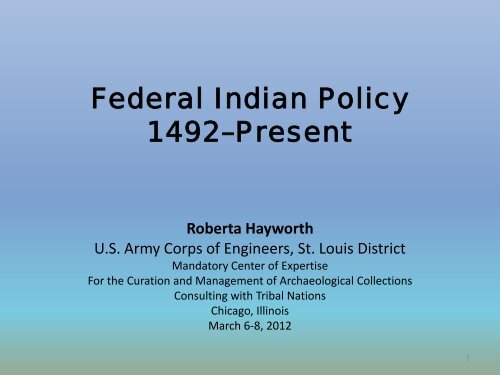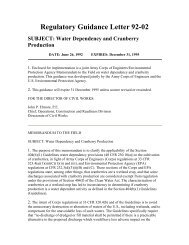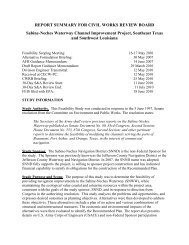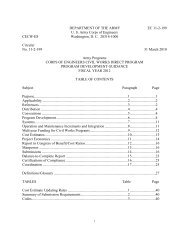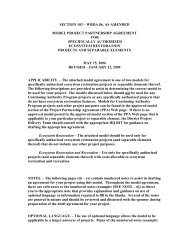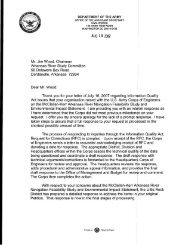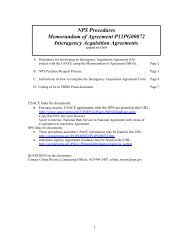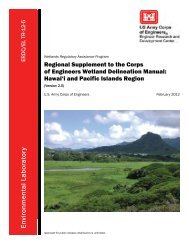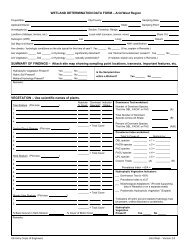Federal Indian Policy 1492âPresent - U.S. Army Corps of Engineers
Federal Indian Policy 1492âPresent - U.S. Army Corps of Engineers
Federal Indian Policy 1492âPresent - U.S. Army Corps of Engineers
Create successful ePaper yourself
Turn your PDF publications into a flip-book with our unique Google optimized e-Paper software.
<strong>Federal</strong> <strong>Indian</strong> <strong>Policy</strong><br />
1492–Present<br />
Roberta Hayworth<br />
U.S. <strong>Army</strong> <strong>Corps</strong> <strong>of</strong> <strong>Engineers</strong>, St. Louis District<br />
Mandatory Center <strong>of</strong> Expertise<br />
For the Curation and Management <strong>of</strong> Archaeological Collections<br />
Consulting with Tribal Nations<br />
Chicago, Illinois<br />
March 6-8, 2012<br />
1
Early Interactions between<br />
European Countries– <strong>Indian</strong> Tribes<br />
•Conflict<br />
•Warfare<br />
•Cultural Clash<br />
•Religious Clash<br />
Europeans wanted resources from the<br />
•Land<br />
•Animals<br />
•Furs<br />
•Water<br />
•Timber<br />
•Minerals<br />
2
The Overriding Theme <strong>of</strong> the Europeans<br />
and New Settlers<br />
• Assimilation or absorbing the tribal population into<br />
the new population<br />
• Eliminating tribal religion and replacing it with<br />
Christian religion<br />
• Eliminating tribal cultures<br />
• Eliminating tribal traditions and way <strong>of</strong> life<br />
3
Overriding Theme <strong>of</strong> the Europeans<br />
• Europeans entered into treaties with <strong>Indian</strong> tribes to<br />
take control <strong>of</strong> the land they were living on and to<br />
enhance peace between settlers and <strong>Indian</strong> tribes<br />
• This was the beginning <strong>of</strong> the European countries and<br />
the yet unformed United States entering into a<br />
Government-to-Government relationship that still is<br />
practiced today<br />
4
Colonial Period 1492-1774<br />
• During this time period all tribes were treated as<br />
sovereign nations<br />
• Treaties were written because policy made the tribes<br />
the rightful owners <strong>of</strong> all the resources found in and<br />
on their land, such as:<br />
─ Prime farm land<br />
─ Gold<br />
─ Silver<br />
─ Timber<br />
5
Confederation Period 1774–1789<br />
• Continental Congress was formed in<br />
September 1774 and lasted until 1781<br />
• <strong>Policy</strong> <strong>of</strong> the Continental Congress toward<br />
<strong>Indian</strong>s was to attempt to keep them neutral to<br />
prevent them from fighting on the English side<br />
• Continental Congress dealt with the tribes on<br />
a diplomatic basis<br />
6
Articles <strong>of</strong> Confederation Congress<br />
1781-1789<br />
• Did not assign exclusive power over <strong>Indian</strong> Tribes<br />
to the <strong>Federal</strong> Government<br />
• Response to states and citizens meddling in <strong>Indian</strong><br />
affairs<br />
• Important function was to handle <strong>Indian</strong> affairs and<br />
prevent wars<br />
7
Constitution<br />
Adopted on September 17, 1787<br />
• Impacts <strong>of</strong> the new wars and conflicts led to the<br />
formation <strong>of</strong> a new and even stronger <strong>Federal</strong><br />
Government<br />
• Exclusive power over <strong>Indian</strong> affairs was now placed<br />
with the <strong>Federal</strong> Government as stated in the United<br />
States Constitution<br />
8
Constitution<br />
Commerce Clause, Article I, Section 8<br />
“To regulate Commerce with foreign<br />
Nations and among the several States,<br />
and with <strong>Indian</strong> Tribes;”<br />
Supremacy Clause, Article VI<br />
“and all Treaties made, or which shall be<br />
made, under the Authority <strong>of</strong> the United<br />
States, shall be the supreme Law <strong>of</strong> the<br />
Land;”<br />
9
Trade and Intercourse Act─1790<br />
• Congressional regulation <strong>of</strong> commerce between <strong>Indian</strong><br />
Tribes and non-<strong>Indian</strong>s<br />
• Restricted travel by non-<strong>Indian</strong>s onto <strong>Indian</strong> land<br />
• <strong>Federal</strong> Government trading houses established to<br />
foster peaceful relations and to bind the tribes<br />
economically to the United States<br />
10
Removal Act─1830<br />
• Authorized President Andrew Jackson to exchange<br />
lands with the <strong>Indian</strong>s east <strong>of</strong> the Mississippi for land<br />
west <strong>of</strong> the Mississippi<br />
• Removal was to be voluntary, although most were<br />
forced<br />
• Tribes were removed to <strong>Indian</strong> Territory which is now<br />
the state <strong>of</strong> Oklahoma<br />
11
Removal Act─1830<br />
Cherokee Nation fought removal and filed law suits<br />
in the Supreme Court<br />
• Cherokee Nation v. Georgia (1831)<br />
• Worcester v. Georgia (1832)<br />
12
Removal Act─1830<br />
Cherokee Nation v. Georgia (1831)<br />
• Cherokee filed a law suit with the Supreme Court to stop<br />
the State <strong>of</strong> Georgia from passing laws that interfered with<br />
the tribe and its territory.<br />
• Cherokee Nation argued that Supreme Court had<br />
jurisdiction because Cherokee Nation was a foreign state.<br />
– Cherokee Nation was not one <strong>of</strong> the states <strong>of</strong> the union<br />
<strong>of</strong> the United States<br />
– Cherokee members were not citizens <strong>of</strong> the United<br />
States<br />
– A government <strong>of</strong> aliens (Cherokee Nation) must be a<br />
foreign state<br />
13
Removal Act─1830<br />
Cherokee Nation v. Georgia (1831)<br />
Supreme Court Ruling<br />
The Supreme Court held that:<br />
• The Cherokee Nation was not a foreign state and<br />
Supreme Court had no jurisdiction<br />
• Cherokee Nation could not sue the state <strong>of</strong> Georgia<br />
• Tribes are states because they entered into treaties with<br />
the United States<br />
• Tribes were domestic dependent nations<br />
14
Removal Act─1830<br />
Worcester v. Georgia (1832)<br />
• New England missionaries sent to prison for entering<br />
Cherokee County without permission <strong>of</strong> the Governor <strong>of</strong><br />
Georgia<br />
• Missionaries appealed to the Supreme Court and were<br />
freed<br />
• The <strong>Federal</strong> Government recognizes tribal<br />
sovereignty<br />
• State jurisdiction was denied<br />
15
Creation <strong>of</strong> Formal<br />
<strong>Indian</strong> Reservation 1850-1887<br />
• Reservation policy was to enter into treaties with<br />
tribes to keep them separate from settlers so<br />
conflicts and battles over land would end<br />
• Treaties clearly defined areas <strong>of</strong> reserved land for<br />
tribes<br />
16
<strong>Indian</strong> Reservations<br />
• Tribes were allowed to reserve vast amounts <strong>of</strong> land such<br />
as:<br />
– 44 million acre reservation for the Shoshone tribe <strong>of</strong><br />
Wyoming<br />
– 1851 treaty with the Sioux Nations included all <strong>of</strong><br />
present-day South Dakota and parts <strong>of</strong> Nebraska,<br />
Wyoming, North Dakota and Montana<br />
• Treaty making was ended in 1871<br />
• Around 300 reservations were established<br />
17
General Allotment Act <strong>of</strong> 1887<br />
(Dawes Act)<br />
• Broke up reservation land by assigning individuals<br />
parcels <strong>of</strong> land<br />
– Head <strong>of</strong> family received 160 acres<br />
– All other members received 80 acres<br />
• Land allotted in checkerboard patterns to break up<br />
– Extended families<br />
– Tribal governments<br />
– Tribal religion<br />
– Tribal culture<br />
• Over 90 million acres <strong>of</strong> <strong>Indian</strong> land was lost<br />
18
Wheeler-Howard Act 1934<br />
(a.k.a. the IRA or the <strong>Indian</strong> Reorganization Act)<br />
• This act secured certain rights to Native<br />
Americans, including the right for tribes to<br />
organize governments and corporations<br />
• Stopped the allotment <strong>of</strong> land<br />
• Returned unsold surplus land to the tribes<br />
• Over 2 million acres <strong>of</strong> land was returned to<br />
various tribes in the first 20 years after passage<br />
<strong>of</strong> the Act<br />
19
Termination and Relocation<br />
1953-1967<br />
• The <strong>Federal</strong> policy was to abolish <strong>Federal</strong> supervision<br />
over Native Americans and to:<br />
– Remove <strong>Indian</strong>s from reservations<br />
– Sell their land<br />
– Split the money among individual tribal members<br />
• Approximately 61 tribes were stripped <strong>of</strong> federal<br />
recognition<br />
20
Western Oregon <strong>Indian</strong> Termination Act (1954)<br />
• Written to terminate 67 tribes<br />
Rancheria Termination Act (1958)<br />
•Written to terminate 40 tribes and Rancherias<br />
Between 1953 and 1964, approximately<br />
109 tribes and Rancherias were terminated<br />
21
Termination<br />
• 1,365,801 acres <strong>of</strong> trust land was removed from<br />
protected status and sold to non-<strong>Indian</strong>s<br />
• In 1963, the <strong>Federal</strong> government stopped the tribal<br />
terminations except the Ponca Tribe <strong>of</strong> Nebraska who<br />
were terminated in 1966<br />
• The Ponca fought for <strong>Federal</strong> recognition from 1967<br />
until they were reinstated on November 1, 1990<br />
22
<strong>Indian</strong> Self-Determination Era<br />
1968–1979<br />
• Act <strong>of</strong> January 4, 1975—<strong>Indian</strong> Self-Determination and<br />
Education Act<br />
– Allowed tribes, under a contractual relationship, to<br />
assume management <strong>of</strong> programs, functions,<br />
services, and activities <strong>of</strong> the Bureau <strong>of</strong> <strong>Indian</strong><br />
Affairs and the <strong>Indian</strong> Health Service that previously<br />
were administered by these agencies without<br />
extinguishing the trust relationship.<br />
– Tribal self rule<br />
– Cultural survival<br />
– Economic development<br />
23
Self-Governance<br />
Where Tribes are Today<br />
• Self-Governance is fundamentally designed to provide<br />
Tribal governments with more control and decision-making<br />
authority over the <strong>Federal</strong> financial resources provided for<br />
the benefit <strong>of</strong> <strong>Indian</strong> people.<br />
• More importantly, it fosters the shaping <strong>of</strong> new<br />
partnerships between <strong>Indian</strong> Tribes and the U.S. in their<br />
government-to-government relationships.<br />
• Self-Governance provides the opportunity for Tribal<br />
governments to exercise their sovereignty with minimal<br />
<strong>Federal</strong> intrusion and involvement.<br />
24
<strong>Indian</strong> <strong>Policy</strong><br />
from 1771 to Present<br />
• Formative Years (1771–1870)<br />
– 1830 <strong>Indian</strong> Removal Act<br />
• Allotment and Assimilation Era (1870–1927)<br />
– 1887 General Allotment Act<br />
– June 2, 1924─All Native American tribal members<br />
became citizens <strong>of</strong> the United States<br />
• <strong>Indian</strong> Reorganization Era (1928–1950)<br />
– June 18, 1934─<strong>Indian</strong> Reorganization Act (also known<br />
as the Wheeler-Howard or the New Deal)<br />
– August 13 1946─<strong>Indian</strong> Claims Commission<br />
25
<strong>Indian</strong> <strong>Policy</strong><br />
from 1771 to Present<br />
• Termination Era (1950–1967)<br />
– August 1, 1953-House Concurrent Resolution #108<br />
• Act <strong>of</strong> August 13, 1954—Western Oregon <strong>Indian</strong><br />
Termination<br />
– Terminated 67 tribes; more tribes than all other<br />
termination Acts<br />
• Act <strong>of</strong> August 18, 1958—Rancheria Termination Act<br />
– Terminated 40 tribes and Rancherias.<br />
26
<strong>Indian</strong> <strong>Policy</strong><br />
from 1771 to Present<br />
• <strong>Indian</strong> Self-Determination Era (1968–1979)<br />
– January 4, 1975—<strong>Indian</strong> Self-Determination and<br />
Education Act<br />
• Allowed tribes, under a contractual relationship,<br />
to assume management <strong>of</strong> programs<br />
• Tribal self rule<br />
• Cultural survival<br />
• Economic development<br />
27
<strong>Indian</strong> <strong>Policy</strong><br />
from 1771 to Present<br />
• Self-Governance (1980 to Present)<br />
– 1994, President Clinton issues the first memo on<br />
Government-to-Government Relations<br />
– 1996, E.O. 13007 on <strong>Indian</strong> Sacred Sites<br />
• 2009, President Obama reissues the memo on<br />
Government-to-Government Relations<br />
28
Questions<br />
29


